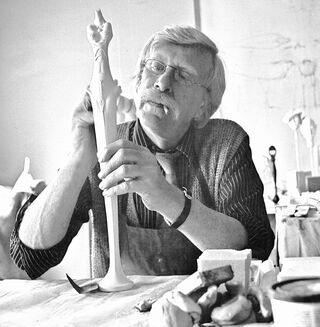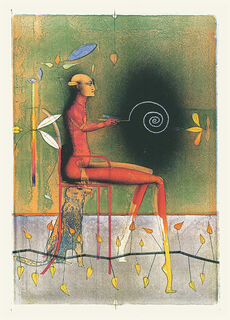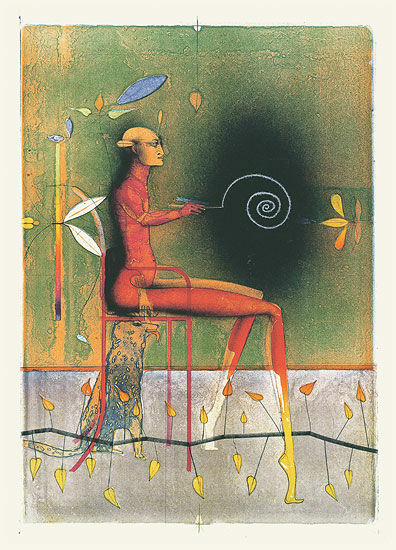Picture "Spiral Painter", unframed


Picture "Spiral Painter", unframed
Quick info
limited, 100 copies | numbered | signed | colour lithograph on handmade paper | unframed | size 66.5 x 91.7 cm
Detailed description
Picture "Spiral Painter", unframed
The spiral is a symbol of the life span of a human being. Unlike the circle, it has a beginning and an end. One could interpret the spiral as the path of a person who expands their life through experience and knowledge in the course of their life. It seems that Wunderlich created the spiral painter as a hidden self-portrait in this sense. Because he deliberately placed the beginning of the spiral at the inner end, at the beginning of life, and symbolised with the drifting apart spiral arcs the progress of life maturing in experience and reflection. A reference to the development and unfolding of his own work.
Original colour lithograph in 8 colours on Zerkall handmade paper. Limited edition of 100 copies, numbered and signed by hand. Catalogue raisonné no. 875. Unframed. Sheet size 66.5 x 91.7 cm.

About Paul Wunderlich
1927-2010
Like no other artist of our time, Paul Wunderlich was one of the most influential style-forming artists of the modern age. Only in 1960, the Hamburg prosecutor seized his works for "indecent". Three years later, the relativley young Paul Wunderlich was hired as a professor at the University of Fine Arts. Numerous awards such as the Edwin Scharff Prize honours at the biennial arts exhibition in Ireland, Taiwan and Bulgaria made Wunderlich internationally famous. He was the only German artist to be admitted to the Paris "Académie des Beaux-Arts". Paul Wunderlich lived and worked both in Hamburg and France until his death in June 2010.
Born in 1927 in Eberswalde near Berlin, the painter and sculptor learned to draw at the Palace School of Art in the Orangery of Eutin Castle. Immediately after World War II, he visited the Hamburg Academy of Fine Arts to study graphic arts. After completing his studies, he remained there working as a drawing teacher and in 1963 became a professor.
In the early 1950s, he met Emil Nolde and Oskar Kokoschka. Under their guidance he printed reproductions of their works. He developed a very idiosyncratic style in which manneristic and surrealistic, as well as elements of Art Nouveau and Art Deco, meet. He initially drew his themes inspired by German history, for example the cycle of lithographs "20 July 1944". Later, erotic and sexual motifs became more significant which he treated with delicacy and also a hint of morbidity. In 1960, one such cycle of lithographs was seized by the Hamburg prosecutor for indecent depictions.
In the 1960s he began to work based on photographs by Karin Székessy. After he resigned from his professorship in 1968, he made several study trips to New York and Switzerland. From then on, he also worked on sculpturally aestheticised everyday objects that were parallel with the subtly crafted imagery of his lithographs.
"His works are recognised, appreciated and also bought by a broad public all over the world," writes Paul Wunderlich's biographer Jens Christian Jensen. "Art connoisseurs agree: Paul Wunderlich is the leading master of fantastic realism and one of the very few style-forming artists of our time."
"Out of all the truisms that are spread about his life's work, only one fact is for sure: the realisation that Paul Wunderlich became the unsurpassed master of lithography after Picasso." (Prof. Heinz Spielmann)
"If one searches for the greatest master in the art of lithography in all its possibilities, there is no doubt that Paul Wunderlich deserves all credits." (Carl Vogel)
The field of graphic arts, that includes artistic representations, which are reproduced by various printing techniques.
Printmaking techniques include woodcuts, copperplate engraving, etching, lithography, serigraphy.


